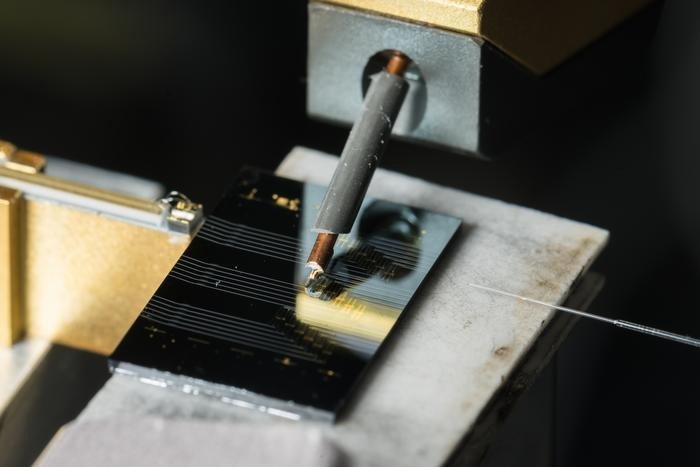Reviewed by Lexie CornerMay 23 2024
Researchers at the University of Rochester have created new microcomb lasers that transcend prior constraints and possess a simple design applicable to various applications. These findings were published in Nature Communications.
 University of Rochester researchers created a chip-scale microcomb laser with an innovative design that allows users to control the optical frequency comb by switching on a power source. Image Credit: University of Rochester / J. Adam Fenster
University of Rochester researchers created a chip-scale microcomb laser with an innovative design that allows users to control the optical frequency comb by switching on a power source. Image Credit: University of Rochester / J. Adam Fenster
Optical frequency combs are light measurement instruments that have transformed atomic clocks, spectroscopy, metrology, and other fields. However, the difficulties in creating frequency comb generators on a semiconductor level have restricted their application in everyday technologies like handheld electronics.
What are Microcombs?
Optical frequency combs produce a spectrum of light. They are composed of several coherent beams uniformly spaced apart and adjusted to different colors or frequencies. The resulting shape resembles the teeth on a haircomb. Scientists have been developing microcombs, miniaturized versions of this technology that can fit on small chips.
Although microcomb prototyping has advanced, scientists have not yet created functional versions for practical applications. Some of the challenges are low power efficiency, restricted controllability, sluggish mechanical reactions, and the requirement for complex system pre-configuration.
A Simplified Approach
A group of scientists headed by Qiang Lin, a professor at Rochester's Institute of Optics and Department of Electrical and Computer Engineering professor, developed a novel strategy to address these problems in a single device.
The lead author of the paper and Ph.D. student in Lin’s lab, Jingwei Ling, claims that prior methods have usually depended on injecting a single wavelength laser into a nonlinear converter, which can then convert the single wavelength into multiple wavelengths to form the optical comb.
We eliminated the single wavelength because that’s going to degrade the system’s efficiency. We instead have all the comb itself being amplified in a feedback loop inside the system, so all the wavelengths get reflected and enhanced inside a single element.
Jingwei Ling, Study Lead Author and Ph.D. Student, University of Rochester
The “all in one” microcomb laser’s simplicity leads to reduced power requirements, cheaper expenses, excellent tunability, and turnkey operation.
It is easy to operate. The previous methods make it hard to excite the comb, but with this method, we only need to switch on the power source, and we can control the comb directly.
Zhengdong Gao, Study Co-Author and Ph.D. Student, Department of Electrical and Computer Engineering, University of Rochester
The implementation of these microcomb lasers continues to present challenges, notably in establishing fabrication processes to generate such tiny components within the required manufacturing tolerances. However, the researchers anticipate their devices will be useful in telecommunications systems and autonomous vehicle light detection and ranging (LiDAR).
The Defense Advanced Research Projects Agency and the National Science Foundation supported the study.
Journal Reference:
Ling, J., et al. (2024) Electrically empowered microcomb laser. Nature Communications. doi:10.1038/s41467-024-48544-2.